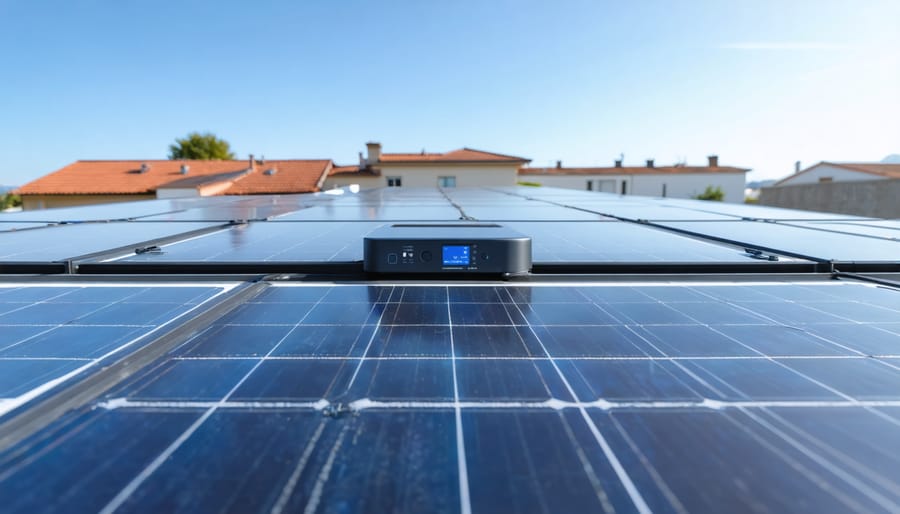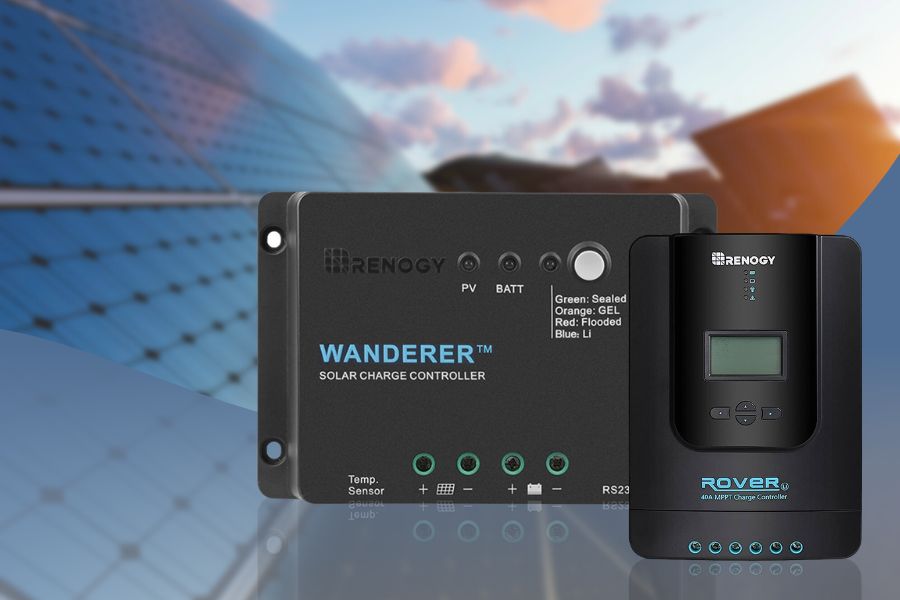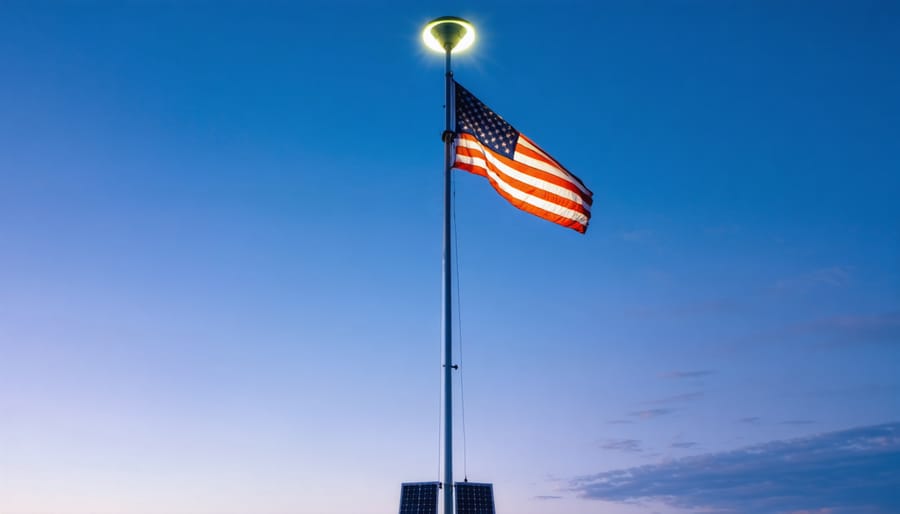MPPT vs PWM – The Difference Explained (With Diagrams)
Updated:

MPPT charge controllers can harness optimal performance from any solar array under a wide range of conditions, while PWM controllers are limited in their scope of application.
But, against the backdrop of modern solar technology, MPPT charge controllers can do it all while PWM controllers can’t. Check out the difference between MPPT vs. PWM charge controllers.
That’s not to say that the PWM solar charge controller is redundant or doesn’t have a meaningful role. In fact, the PWM controller is king in smaller trickle charging applications. They are also particularly suited to scorching climates where solar irradiation is optimized.
Classification of MPPT and PWM Charge Controllers
Smaller, lighter, and cheaper than their MPPT peers, they are ideal for non-essential lighting, electric gates, irrigation stations, and electric fences. Essentially, any system that operates occasionally and doesn’t tax the batteries much will definitely benefit from a PWM charge controller.
However, any larger, high-demand, on-grid solar system supporting essential equipment or services should always be equipped with an MPPT controller. MPPT controller’s sophisticated circuitry allows them to leverage maximum potential from large solar panel arrays and all common battery voltages.
And they deliver the same performance under adverse solar conditions. This makes them particularly suitable for colder climates and heavily shaded locations.
MPPT vs PWM Controllers: The Importance of the Choice
A lot of folks view the MPPT vs PWM debate from a simplistic cost perspective. Although this is a significant consideration, it isn’t the most important. The big-picture viewpoint is far more complex and contributes more to solar efficiency than pure dollar and cents considerations.
Utilizing solar power properly results in creating a fine balance between your environment, power needs, and the chosen components. Naturally, you can go out and randomly buy components, slap them down in a sunny area, and you’ll have power.
However, you could be wasting hundreds or even thousands of dollars a year. Either from unnecessary initial expenditure or lost solar potential because of bad component choices.
And the MPPT vs. PWM choice is one of the most important of those component choices.
To make canny choices in the MPPT vs. PWM showdown, you should understand the basic differences between their operation and capabilities.
What Is a Solar Charge Controller?
A solar charge controller is a device that acts as an interface between solar panels and batteries. The prime function of the solar charge controller is to ensure that the battery is not overcharged. In addition, they include functions that optimize solar cell outputs and the resultant battery charging.
Do You Have to Use a Charge Controller?
Not always. You won’t need a controller for micro solar systems with solar panels with 5 watts or fewer outputs. For anything bigger, you will definitely need a solar charge controller.
PWM Controllers

PWM (Pulse Width Modulation) charge controllers are essentially simple switching interfaces between the solar panels and the batteries. They work by switching the power generated by the solar panels on and off in a regular, square wave pulse pattern, as illustrated below.

A pulse width modulation controller will adjust the duration of the on-and-off cycles to control the amount of power they pass through to the battery. For example, to reduce the power transfer to 20 percent, the controller will turn off 4 times as long as it is on, as illustrated in A below. Increasing the amount of power transferred to 80 percent will turn on 4 times longer than off, as in B below.
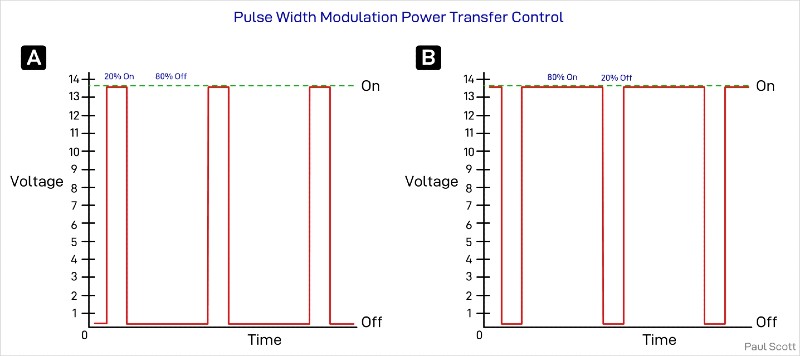
So now the PWM name becomes clear. The controller controls its charge rate by Modulating (adjusting) its output Pulse Width, i.e., Pulse Width Modulation.
In this way, a PWM controller precisely controls battery charging by gradually adjusting its output as the charge level changes. One thing it can’t do, though, is process high PV panel voltages.
This means you’ll be restricted to using solar arrays with voltage outputs close to or slightly above the battery voltage. This can be a seriously limiting factor, as we’ll discuss a little later.
MPPT Controllers

Before we expand on the operation of MPPT (Maximum Power Point Tracking) charge controllers, let’s explain some important characteristics of solar panels.
Average Solar Panel IV Curve
The output of all solar panels can be graphically illustrated using what is known as an IV curve. This curve is typically depicted on a two-axis graph, one axis for output current (I) and one for voltage (V).
Here is an illustration of a typical Isc – Voc relationship or IV curve. The intersection point on the voltage axis is Voc or open-circuit voltage. The current axis intersection point is Isc or short circuit current. This particular curve is based on the outputs of a 100-watt, 12-volt Renogy panel.
Both these points represent the maximum values for both components. The curve represents the working relationship between the two during normal operation.

Solar Panel Power Curve
A solar cell power output is expressed in Watts (W) and is a function of the IV curve. The solar panel maximum power calculation is Power = Voltage x Amperage or P = V x A. In the Renogy panel, the calculation would look like this using optimal voltage and amperage figures.
P = 22.5 V x 5.29 A
P = 119 Watts maximum power
The maximum power voltage curve is usually depicted along with the IV curve on an expanded, 3-axis graph, as illustrated below.

The point where the power and IV curves meet is known as the MPP or maximum PowerPoint. This is where the panel produces its maximum output voltage and power figures for those specific circumstances. It is generally slightly lower than the rated power due to internal inefficiencies.
The curves above represent panel outputs under optimal conditions. As the sun travels across the panel location or shading occurs, those curves will migrate across the graph. And the maximum power voltage point will follow them.
Here is an example of the power and MPPT controller IV curves at different times of the day.
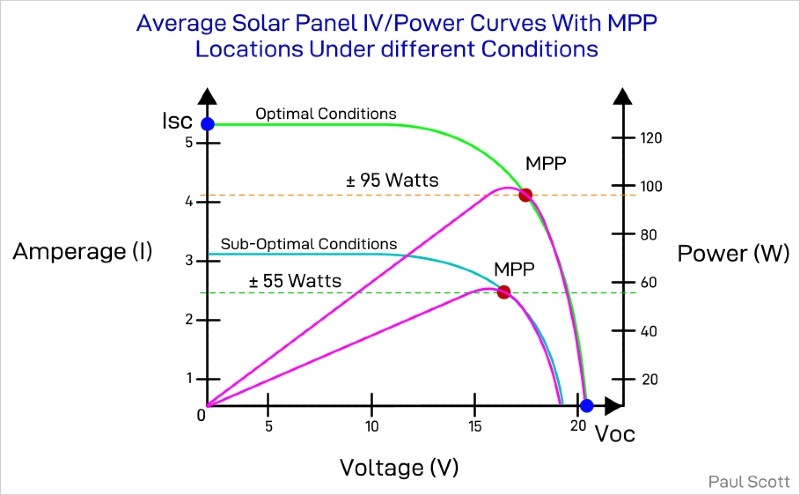
As you can see, the panel outputs will seldom remain static for long. And that’s where the maximum power point tracking charge controller works magic. MPPT solar controllers monitor these output power changes and “track” the MPP point while constantly adjusting its operation accordingly.
This ensures the solar charge controller will always leverage the maximum possible power under all conditions throughout the day.
PWM vs MPPT Charge Controllers: The Pros and Cons
Notwithstanding the substantial differences in the capabilities of these solar controllers, each has a place in today’s solar arena. Let’s look at an overview of both.
PWM Controllers
A PWM controller is affordable, small, and light while robust and reliable. Fewer, less complex parts usually mean a PWM controller will outlast an MPPT charge controller. They do a good job of delivering on solar controllers’ core functions but have limitations. Here are the pros and cons of the PWM solar charge controller.
Pros
- Effective and reliable.
- Operate efficiently in hotter environments.
- Lower cost (anywhere between 20 to 50 percent less).
- Smaller and lighter than an MPPT controller.
Cons
- Not as efficient as MPPT controllers (typically 25 percent less).
- The solar array voltage has to match the battery voltage.
- Noisy and generates a lot of RF (radio frequency) interference.
- Seldom feature battery temperature compensation functions.
- Initial cost savings can be lost to additional wiring outlays due to the higher currents involved.
MPPT Controllers
The maximum power point tracking charge controller represents the current cutting edge of solar charge regulation. The MPPT charge controller is more expensive, but its considerable performance benefits would exert that over time.
In fact, there are a good number of applications where you couldn’t use a PWM controller. Here are the pros and cons of MPPT solar charge controllers.
Pros
- Highly efficient (typical efficiency ratings of 90 percent plus are average)
- Increased efficiency equates to very excellent time savings.
- Very flexible regarding solar array sizes.
- Equally flexible with solar panel sizes (Can accommodate 60 and 72-cell panels).
- Can accommodate all common battery voltage parameters.
- Work well in colder climates and heavily shaded locations
- Almost exclusively includes battery temperature compensation.
- Very quiet.
Cons
- High initial cost (anything up to double the cost of a PWM solar controller).
- Shorter service life
- Larger and heavier than PWM solar controller modules.
MPPT vs PWM Charge Controllers: The Where and When
As we have mentioned earlier, each type of controller shines in particular circumstances. Let’s look at that in more detail now.
The PWM Controller
Climate and Location
PWM solar controllers work particularly well in very scorching where the benefits of MPPT modules are reduced significantly.
Battery and Solar Panel Voltage
The PWM controller can only be used in systems where the solar panel output matches the battery voltage. This is probably one of the type’s biggest drawbacks. The significance of this will be illustrated in the next point.
Wiring Configuration of Solar Panels
You only have a limited choice of series or parallel wiring panel wiring with a PWM module. So why is that an issue?
Although PWM controllers are available in a range of input voltages, the maximum is typically 48 Volts. One of the best ways to optimize solar systems is to increase the surface area of the solar array. This means using bigger panels or adding additional panels.
So, if you had a 48-volt system, the maximum input the PWM controller could handle would be around 60 Volts. If you chose to use 36 cells, 12-volt panels with 21-volt Voc ratings, you could only connect 3 in series.
Any additional panels would have to be connected in parallel to keep the maximum voltage below 60 volts.
As soon as you do that, you cap the panel output voltage but boost the amperage. The result is an increase in the amount of wiring and required wiring gauge. Not to mention additional connectors.
These additional costs will quickly reach a point where you would kiss all the savings on a PWM module goodbye. And to add insult to injury, you’d also still be lumbered with the inherent inefficiency of PWM controllers.
Battery Types
PWM controllers are compatible with the majority of common battery types. That said, the majority of PWM modules don’t include battery temperature compensation features. So, if you choose to use lead-acid batteries, you’ll have to shop around for a PWM module that does.
On or Off-Grid
PWM modules are not suitable for on-grid systems as a rule.
The MPPT Controller
Climate and Location
Although MPPT controllers work well in all climatic conditions, they excel in colder and less optimal solar conditions.
Solar Panel and Battery Voltage
This is one of the MPPT controller’s strong suits, especially in regard to PV input voltage. They can cater to a wide range of input voltages from 24 volts to 200 volts or more.
And, as MPPT controllers “crop” the PV voltage to suit the battery’s needs, it is used with any battery voltage configuration.
Wiring Configuration of Solar Panels
Again, this is another area where the MPPT controller overshadows its PWM counterparts. Due to its typically generous input voltage capacity, it’s much easier for users to upsize their arrays.
In the PWM example, it would only be possible to stack 3 panels in series. With an MPPT controller, you could series wire 10 panels into a 200 Volt controller. Or two 10-panel strings in parallel with minimal amperage gain.
Battery Types
The MPPT solar charge controller is compatible with all battery types. As most include battery temperature compensation features, they’re also perfect for sealed or flooded lead-acid batteries.
On or Off-grid
MPPT controllers are suitable for both on and off-grid solar systems.
The MPPT vs PWM Overview
At this point, it’s worth noting the following. When MPPT solar charge controllers first hit the market in the mid-1980s, it does not intend to be niche products. They were not meant to be the next big thing for cold, cloudy climates. And they were certainly not meant to be supplemental to PWM charge controllers.
The design is to be the future of solar charge regulation. And so they are. They can do everything a PWM controller does and then some. The price of MPPT modules is coming down, slowly eliminating the major pro factor for PWM solar charge controlling. Soon, they will be the only choice, and rightly so.
In Conclusion
A PWM controller is still a viable option if your solar power system is modest, off-grid, and doesn’t support essential services. Particularly if you live near the equator or in any scorching climate.
On the other hand, if your solar system is on-grid or supports essential whole-home energy requirements, you should use an MPPT charge controller module.
The bottom line is this. If you can in any way afford to use an MPPT charge controller, do it. There are simply no arguments for not doing so.
If you’d like to add insights or experiences to our article or ask any questions, please use the comments section below.






